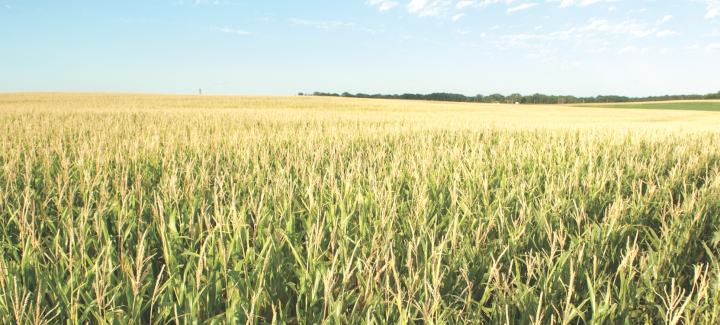
A recent article by Farm Journal titled “Seize Your Corn Yield Potential with Sulfur’s Amazing Superpowers” highlights sulfur’s use in agriculture and its supporting role with nitrogen in crop production. We at Stine have always stressed the importance of sulfur as part of a super management approach to nutrient management.
“Without adequate amounts of sulfur, it becomes increasingly difficult to achieve top-end yields,” says Brian Hartman, Stine’s national corn product manager. “While the three main players in nutrient management tend to be nitrogen, phosphorus and potassium, sulfur is just as important. It works in tandem with nitrogen, so we always recommend growers consider sulfur if they’re applying nitrogen.”
WHAT IS THE ROLE OF SULFUR IN PLANTS?
The role of sulfur in plants is important to chlorophyll production and photosynthesis. Essentially, it helps convert sunlight into energy and supports the plant’s nutrient uptake.
“Sulfur has a direct role with nitrogen; it helps metabolize nitrogen, which also happens to be the No. 1 nutrient in crop production,” says Hartman. “Sulfur is also known to help protect crops from disease. They call this S-dependent resistance.”
Farm Journal Field Agronomist Ken Ferrie notes that sulfur and nitrogen are “structure-building components, so sulfur (like nitrogen) is required early in the season. The plant needs sulfur to build the factory that will produce the fruit.” He explains that insufficient sulfur will result in stunted plant growth or delayed crop maturity.
Sulfur is a macronutrient, so plants deplete it in larger quantities. Typically located in the organic matter of the soil, it cannot be translocated through the roots to the rest of the plant until it has mineralized and converted to sulfate. Then, the nutrient is mobile and acts like nitrogen. To mineralize sulfur into its sulfate form, organic material makeup in the soil must decompose. If this doesn’t happen, that’s when sulfur deficiency can occur.
DEFICIENCY OF SULFUR IN PLANTS
Sulfur deficiency can closely mirror nitrogen deficiency, so it’s important when conducting soil samples to ask the labs to also test for sulfur. There are a few different reasons why your soil may lack sulfur, including taking out the previous year’s crop.
“Harvest can remove approximately 8 to 17 pounds of sulfur per 100 bushels of corn,” says Hartman. “For soybeans, it can remove approximately .2 pounds per bushel. You need to put sulfur back in to replace what you took out with the previous crop.”
Ferrie notes in the Farm Journal article that a 200-bushel corn crop can remove up to 34 pounds of sulfur per acre.
Reduced greenhouse gas emissions are also suspected to cause deficiency as less sulfur dioxide in the atmosphere means less sulfur is deposited back into the soil. Roughly 20 years ago, we may have gotten about 70 to 90 pounds of sulfur per acre from the atmosphere. Now, with the controlling of air pollution, we receive about five pounds per acre.
The evolution to more plants per acre is also a factor.
“The higher the planting populations and the more plants you have per acre, the more nutrients are consumed,” says Hartman. “While we still encourage planting in high-population environments as it equates to higher yields, we also recommend a super management approach that includes applying additional sulfur to support this increase.”
Deficiency symptoms of sulfur in plants
Experts from the Iowa State University Extension and Outreach note that deficiency symptoms of sulfur are sometimes mistaken for nitrogen deficiency. Classic symptoms of nitrogen deficiency include “yellowing of lower (older) leaves, from the leaf tip to the base down the midrib.” In sulfur deficiency, symptoms include “yellowing of new leaves (in the whorl, sometimes with interveinal striping), with lower (older) leaves remaining uniform green.”
HOW TO APPLY SULFUR TO PLANTS
Start with soil sampling. Sometimes, labs will not test for sulfur, so you must request a sulfur test with your regular nutrient test. From there, soil fertility specialists recommend amounts to include in your application. Right now, recommendations would be for in-season applications of sulfur.
Sulfur can be applied to plants in a few different ways.
In-season. Getting the sulfur to the plant as soon as it needs it is imperative. Corn takes up 38% of sulfur during the final three stages of growth. Consider a side-dress or over-the-top application with rates of phosphorus, potassium and nitrogen along with the sulfur. Sulfur should always be added to an in-season nitrogen fertilizer application.
Fall application. Put back what you take out after harvest with a fall soil application. This allows the nutrients more time to break down into the sulfate form to use with next year’s crop. Our experts recommend using ammonium sulfate or ammonium thiosulfate at one pound for every five to 10 pounds of nitrogen.
To learn more about the value of sulfur in crop production, contact your local Stine® agronomist or sales rep for more information.
Related Articles
-

Use Stine’s XP® seed treatments to prevent early injury to your crops
December 2025 in Agronomy
-

Understanding Stine’s enhanced oil profile soybeans
December 2025 in Agronomy
-

Soil sampling sets the stage for spring
November 2025 in Agronomy
-

Corn production growth paves way for more high-performing Stine® hybrids
November 2025 in Agronomy



